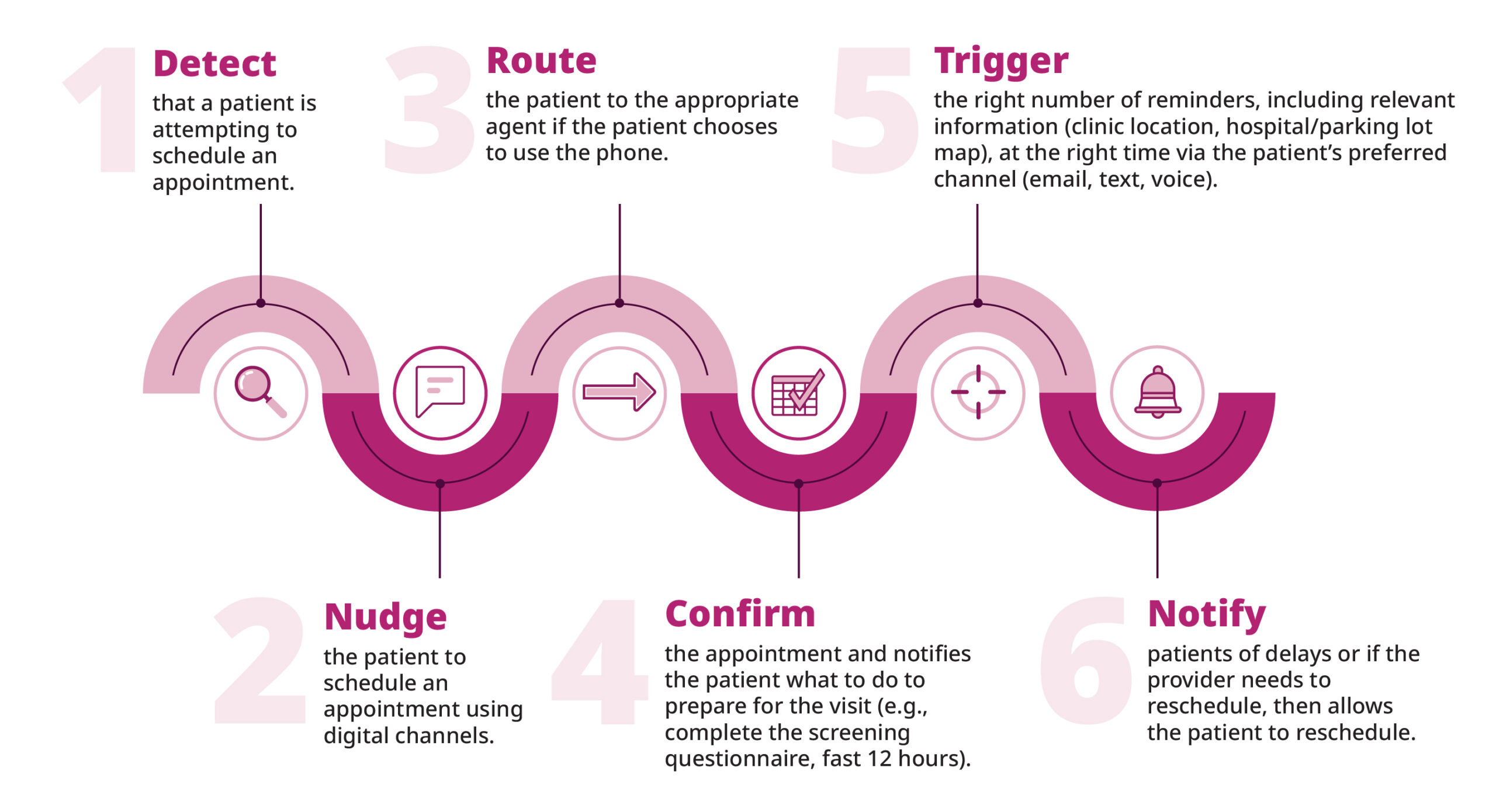Does your digital experience measure up to your high-quality, compassionate clinical care?
Customers in today’s digital-first world compare you to the best experience they’ve had—regardless of industry. Patients expect their entire healthcare encounter to be as easy as booking an Uber or shopping on Amazon. Patients of all ages want online appointment scheduling, and younger patients particularly appreciate online appointment check in, price transparency tools and bill pay.
Healthcare experiences often fail to meet patient expectations. Interactions with healthcare providers are often inconvenient and stressful from start to finish. Selecting an in-network provider, getting a referral, making an appointment and finding the clinic—and the right parking lot—are hassles that seem even worse when you’re not feeling well and are worried about your health. You receive 10 appointment reminders, but none includes the clinic address, so you drive to the wrong location. After your exam, you’re surprised to discover you owe $300 for a procedure you thought was covered by your health insurance. Frazzled by the entire experience and rushing to get back to work, you forget what you’re supposed to do to lower your cholesterol—before you even get to your car.
What is patient experience?
Patient experience (PX) refers to the overall experience a patient has with a healthcare provider or health system—before, during and after receiving medical treatment.
According to the Agency for Healthcare Research and Quality, “patient experience encompasses the range of interactions that patients have with the healthcare system, including their care from health plans, and from doctors, nurses, and staff in hospitals, physician practices, and other healthcare facilities. As an integral component of healthcare quality, patient experience includes several aspects of healthcare delivery that patients value highly when they seek and receive care, such as getting timely appointments, easy access to information, and good communication with health care providers.”
PwC’s Health Research Institute identified five pillars of healthcare customer experience. The quality pillar includes administering only the tests, medications and procedures that are medically necessary, and prescribing drugs based on clinical evidence. The other four pillars include human and digital interactions (only the latter are mentioned here):
- Convenience (e.g., convenient scheduling, online bill payment and registration; getting test results without seeing the doctor)
- Support (e.g., self-service to navigate the health system)
- Personalization (e.g., communication based on patient preferences, prescription refill reminders, help managing
- Communication (e.g., upfront explanation of out-of-pocket costs, not having to repeat information, online portal for health management)
How can healthcare providers improve PX?
Be empathetic. Improving PX starts with understanding what patients are going through when they interact with your healthcare system. In the healthcare environment, empathy involves understanding patients’ feelings, concerns and circumstances—and acting upon that comprehension in a way that conveys your empathy. Treating patients with empathy boosts diagnostic accuracy, patient satisfaction and adherence to medical advice. It also reduces medical complications and psychological distress.
When we talk about empathy in a healthcare setting, we usually think about how healthcare professionals treat their patients. While provider empathy is essential, there’s another important way to use empathy to improve PX: Consider patient needs when designing interactions. Doing so will improve the overall patient journey.
A patient journey refers to the series of interactions a patient has with your healthcare organization to accomplish a particular task (e.g., schedule an appointment, pay a bill, manage their health condition after the visit, etc.). For example, to schedule an appointment online, a patient logs in to the online portal, provides or updates insurance information, completes the health screening questionnaire, selects the desired provider and clinic location, views the available appointments, selects a day/time and then receives a confirmation. If anything goes wrong in this process (e.g., the patient can’t log in to the portal, or the available appointments don’t show up), scheduling the appointment becomes a frustrating experience.
When you understand patients’ needs, emotions and pain points (figurative as well as literal), you can design communications and implement digital tools that make patients’ healthcare journeys less painful. For example, you can use a journey management system to send follow-up instructions—including a list of prescription discount programs—via the patient’s preferred communication channel.
You can even train your conversational artificial intelligence-powered chatbot to convey empathy. In one study comparing physician and chatbot responses to 195 patient questions on Reddit’s “AskDocs” forum, chatbot responses were preferred over physician responses and rated significantly higher for both quality and empathy.
Use customer journey management. According to a survey of 122 patient experience leaders in healthcare, PX leaders have seen patient expectations increase in the past few years. More than half of respondents said patients 1) have an increased demand for quicker response times (57%), and 2) expect seamless integration of departments for quick support/problem resolution (56%).
Most PX leaders (74%) find it difficult to identify where to start to improve patient journeys. Patient engagement solutions help healthcare organizations meet patient expectations/demands, but these tools are underutilized in healthcare. More than half (55%) of respondents are not using any patient engagement solution (PES), and 56% of the organizations that are using a PES are not using a journey orchestration platform.
Patient journey management refers to using real-time patient data to analyze current behavior, predict future behavior and send the right messages at the right time via the patient’s preferred communication channel. Journey management is the key to delivering smarter, personalized notifications related to these critical patient journeys:
- Scheduling/managing appointments
- Receiving test results
- Managing prescriptions (e.g., receiving prescription refill reminders)
- Paying bills
- Managing a chronic disease (e.g., receiving instructions and reminders to take medication or measure blood pressure)
How can customer journey management activate these insights?
Making an appointment is a patient’s first interaction with your health system, so it sets the tone for the rest of the encounters. A cumbersome, time-consuming scheduling process is frustrating. To be engaged in their care, patients must show up for their diagnostic, treatment or wellness visit. A patient who doesn’t receive an appointment reminder may miss the visit, have their symptoms worsen and incur a no-show fee. A patient who isn’t notified of a delay won’t be happy to wait two hours to see the doctor. To prevent these PX-damaging experiences, use a journey management system to send notifications that simplify every interaction.
To manage this journey, the system will:
Discover more best practices to improve PX and retention.
New research shows CX-specific solutions benefit the patient, frontline staff, and healthcare organizations as a whole.


